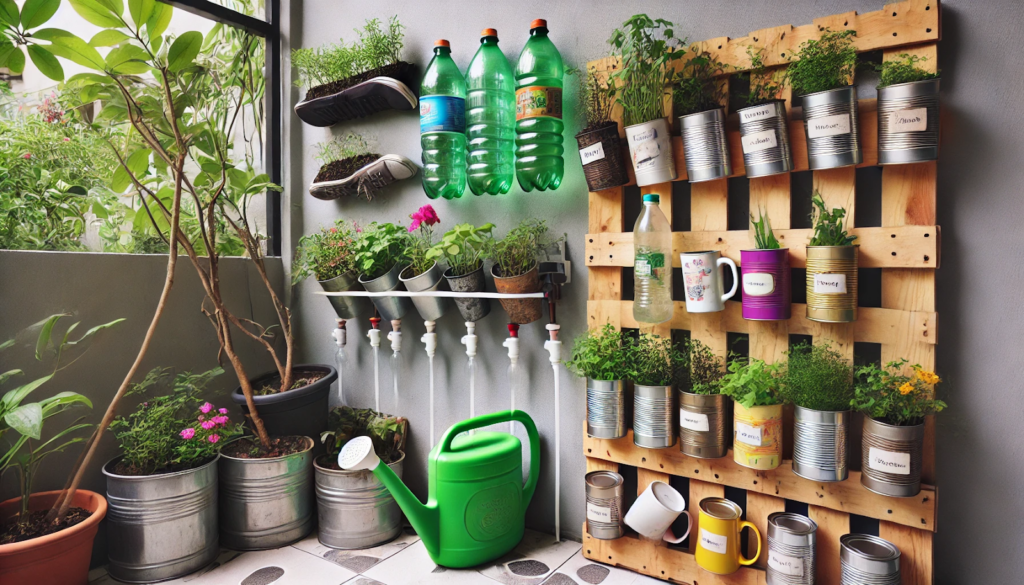Gardening doesn’t always require buying new tools, containers, or fancy systems. In fact, your home is filled with reusable items that can be transformed into functional, eco-friendly gardening solutions. Reusing household items not only saves money—it also reduces waste and adds creativity to your gardening space.
In this guide, you’ll discover practical and fun ways to reuse everyday objects to support your gardening efforts, no matter the size of your space.
Why Reuse Household Items in the Garden?
- Save money by avoiding unnecessary purchases
- Reduce landfill waste and repurpose what you already own
- Spark creativity with unique and personalized garden setups
- Encourage sustainability by giving items a second life
1. Turn Plastic Bottles into Drip Irrigation Systems
Plastic bottles are perfect for making slow-release watering systems.
How:
- Poke small holes in the cap or sides of a bottle
- Fill with water
- Bury it neck-down near plant roots
The bottle slowly releases water, keeping soil consistently moist.
2. Use Tin Cans and Jars as Planters
Don’t toss those food cans and glass jars—turn them into charming plant containers.
How:
- Clean thoroughly
- Add drainage holes to cans (skip for jars used indoors with pebbles)
- Paint or decorate for style
- Use for herbs, succulents, or seedlings
3. Grow Herbs in a Hanging Shoe Organizer
A hanging shoe rack can become a vertical herb garden—perfect for balconies and small spaces.
How:
- Fill each pocket with soil and herbs
- Hang in a sunny location (like a fence or wall)
- Water gently and label each pocket
Tip: Drill small holes in the bottom for drainage if needed.
4. Use Old Mugs, Cups, and Bowls for Indoor Plants
Mismatched mugs and bowls make stylish planters for windowsills or desks.
How:
- Add small stones at the bottom for drainage
- Use for succulents, cacti, or low-water plants
- Group several for a mini indoor garden
5. Convert Pallets into Vertical Planters
Wooden pallets are ideal for building vertical gardens or raised beds.
How:
- Sand and treat the wood
- Add landscaping fabric to create planting pockets
- Fill with soil and insert herbs, flowers, or leafy greens
Mount against a wall or lean securely.
6. Use Egg Cartons as Seed Starters
Cardboard egg cartons are biodegradable and easy to use.
How:
- Fill each cell with seed-starting mix
- Plant one seed per cell
- Water gently and place in a sunny spot
- Transplant entire cell into the ground when ready
7. Reuse Spoons, Forks, or Popsicle Sticks as Plant Labels
Use kitchen utensils or craft materials to keep your garden organized.
How:
- Write plant names on the handle with permanent marker
- Stick into the soil at the base of each plant
- Decorate for added flair
8. Make Compost Bins from Buckets or Trash Cans
Old containers can become efficient compost bins with just a few tweaks.
How:
- Drill holes for airflow
- Add kitchen scraps, leaves, and garden waste
- Stir weekly to speed up decomposition
- Harvest compost in a few months
9. Grow in Reusable Shopping Bags or Tote Bags
Reusable fabric bags can double as flexible grow bags.
How:
- Line the bottom with cardboard or straw
- Fill with potting mix and compost
- Plant herbs, lettuce, or potatoes
- Place on a balcony, deck, or patio
10. Build Mini Greenhouses from Clear Containers
Clear storage bins or plastic clamshells from salad mixes work well for trapping humidity and heat.
How:
- Use as seed starting chambers
- Place in a warm, sunny area
- Vent daily to avoid mold
11. Use Broken Pots for Drainage or Decorations
Don’t toss cracked planters—repurpose them.
Ideas:
- Use shards at the bottom of pots for improved drainage
- Create fairy gardens or succulent displays with fragments
- Label plants with flat broken pieces using paint or marker
12. Grow Sprouts in a Mason Jar
Growing sprouts is fast, fun, and healthy—and only requires a jar and water.
How:
- Add 1–2 tablespoons of seeds (alfalfa, mung bean, lentils)
- Rinse and drain twice a day
- Use a mesh lid or cheesecloth for airflow
- Harvest in 3–5 days
13. Store Seeds in Pill Organizers or Envelopes
Old pillboxes, mint tins, or DIY envelopes make great seed organizers.
How:
- Label each compartment or envelope
- Store in a cool, dry place
- Keep a log of planting dates and results
14. Use CD Spindles or Takeout Containers for Mini Greenhouses
Transparent lids and containers trap moisture and heat like mini domes.
How:
- Place seedlings or cuttings inside
- Leave in bright light
- Lift lid for ventilation every day or two
15. Reuse Food Packaging for Trays and Watering Mats
Old trays, containers, or lids can be used under pots to catch excess water or keep things clean.
How:
- Place under small pots indoors
- Use as trays to start multiple seedlings
- Catch drips from hanging baskets or shelf planters
Reusing Is Smart Gardening
By reimagining common household items, you can build a garden that’s both creative and cost-effective. Whether you live in a small apartment or have a spacious backyard, there’s always something around the house that can be repurposed to make gardening easier, greener, and more fun.






